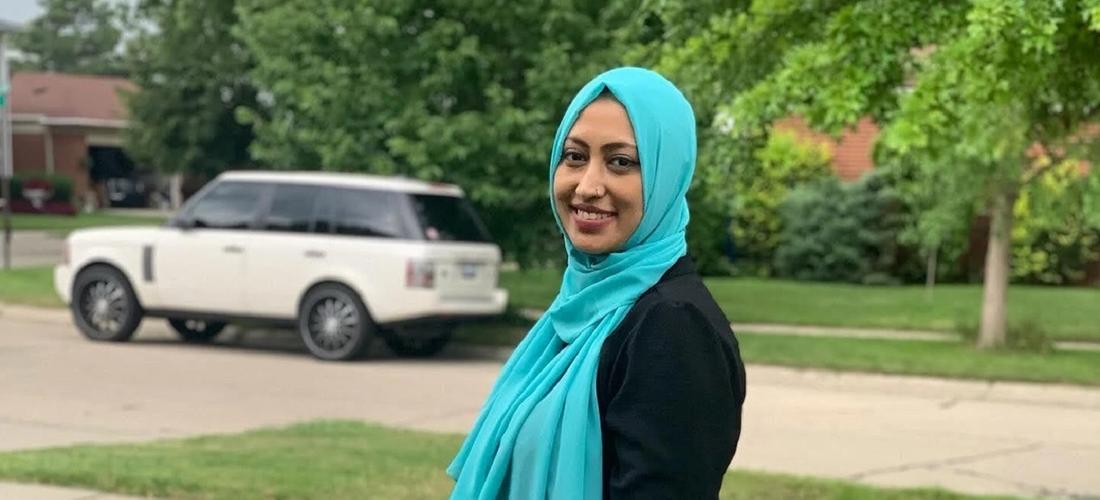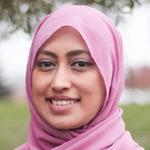Living Visibly Muslim – HH's Nargis Rahman Forging Her Path Forward Post 9/11
Current Events
|
Sep 13, 2021
|
6 MIN READ

Journalist and The Haute Take writer Nargis Rahman
This article is part of a special series exploring our stories as visibly Muslim women in the last two post-9/11 decades.
Twenty years ago I was in middle school when 9/11 happened. It has forever changed the way I became a visible Muslim in Metro Detroit. I didn’t know at the time that Muslims would be subjected to backlash due to the attacks, but I felt a sense of needing to come together after the incident.
There was a sense of dread that lingered in the air. However, I went to a school in Hamtramck, Michigan with about 80 percent of Muslim students from Bangladesh, Yemen, Bosnia, Pakistan and other countries. Teachers did not lash out against the students for what happened, as opposed to the cases of bullying and microaggressions that increased across schools in the U.S. (follow the hashtag #afterseptember11 to learn more). At my school, I blended in.
But a few days after the attacks a group of girls harassed me on the way home, and one tried to remove my hijab. Imagine going through that as a middle schooler. This made me feel on guard.
However, my shock and understanding of what was happening came about slowly. I had yet to fully grasp what had happened and what was happening all around me. On the news, I would hear reports of older men getting attacked walking on their way to the masjid over the next few years.
When I turned 15, I had applied for an admin job in Taylor, Michigan that was owned by two Muslim doctors. The one who took my interview said, “You will have to remove your scarf if you want to work here.” I politely said, “Okay,” and left. When I got to the car I felt a sense of shame. I didn’t tell my dad what happened inside, feeling the pangs of hurt that even our ummah can’t stand up for Muslim women. Instead, I told my dad that I didn’t want to drive out that far on my own for a job and never looked back.

The author as a young girl.
Once I started college in 2006, reality hit differently. On Wayne State’s college campus, I reflected and took a deeper dive into learning my religion, participating in the Muslim Students’ Association, volunteering, going to halaqas (Islamic and Quran study circles) and conferences. By then I didn’t wear hijab because my parents expected me to or I figured that’s just what I was supposed to do, or that it was part of my faith – rather, I better realized the purpose and beauty behind wearing it.
I was also going through my first identity crisis at the time and wanted to further understand my purpose as a human being, as a Muslimah, and embrace the roles that would come with that in my future profession as a journalist. One of my favorite occurrences was learning about hijab with Najah Bazzy, a transitional nurse who at the time did a halaqa during our college’s Islam Awareness Week and spoke about (among other things) the hijab. It made me so proud to be Muslim and wear hijab. (I’d later go on to interview her for HH when she was nominated as one of CNN’s Top Ten Heroes of 2019.)
Through my circle of new MSA friends on campus (I entered college thinking I wouldn’t make any friends but instead I made great ones), I learned to be unapologetically Muslim in all areas of my life. We prayed together in library corners and empty classrooms, we volunteered and attended lectures. We had women-friendly gatherings.
At internships I had, I asked for accommodations to pray, oftentimes explaining why it was important to me and always getting my requests approved. I remember sitting in an editorial meeting where a reporter was talking about Muslims passing out Qurans in a nearby county with confusion and scorn, only to see me quietly looking over at her as a curious intern. Later the same reporter asked me questions about my faith and practices, and we bonded over food.

The author at work.
There were times where I had to pray in the news truck at a TV station or in the empty editorial room. Sometimes I had to search around for a spot to pray. Other times I was asked questions like why I didn’t shake hands with men, prompting me to write a reflective piece for my college newspaper about what Islam was about anyways. I know, a rather heady undertaking for a college student.
I realized I was back in familiar terrain – explaining myself and religion – something I was used to doing as a kid.
Many other Muslims have written about how they didn’t like or resented being thrust into this role of “public Muslim” or explaining aspects of Islam all the time. For me though, I was so normalized by it, that I didn't mind. When I lived in Hamtramck, most people didn’t ask you why you wear hijab; they either know or don't care. They are used to seeing hijabis. But once outside of my insular community, out in the real world, I get asked it a lot. I generally think people are curious. Sometimes it can be exhausting, feeling like I'm the only one or that I'm being asked because I'm being judged. But at the same time I’m used to asking and being asked questions as a journalist.
In 2012 I began working for CAIR Michigan, where I learned firsthand about harassment, hate incidents, bias, people being put on watchlists and people being harassed by the FBI. That job took what I had already experienced and showed me the extent of what was going on for too many Muslims in the United States. That knowledge equipped me with the tools, language and understanding of what was at stake when we don’t speak up.
Nearly a decade later, I’m seeing women like activist Linda Sarsour, who popularized the term “unapologetically Muslim,” Ibtihaj Muhammad, who competed for team U.S.A. in the Olympics team as a sabre fencer in 2016 and helped put Muslims on the map in sports, young women like Noor Alexandria Abukaram, who was disqualified by the Ohio High School Athletic Association for wearing hijab and challenged the rules that left them out in the first place – all normalizing hijab in the mainstream. Mainstream companies like Nike, CoverGirl, Old Navy and Gap featuring Muslim women in their marketing helped reclaim a space for hijabi women who dare and care to wear hijab in the public domain.
Muslim-owned companies, like Haute Hijab, keep showing us that we are the most powerful women in the world, and that we can do anything we want to as proud and visibly Muslim women.

The author at work.
Social media has a lot to do with this evolution too. Due to image-centered mediums like Instagram, Facebook and Snapchat, people have an insider’s view into “everyday Muslims.” (Although it’s important to point out that a lot of what we see on social media is also curated.) The truth is many people don’t know someone who is Muslim and cannot relate to their lives, and social media has helped in some small ways to change that.
News anchor Tahera Rahman became the first television anchor to wear hijab in the U.S. for a major mainstream media channel, something journalists like me never thought we’d see in our lifetimes.
In the past year, I watched the Black Lives Movement take off in a way that it hasn’t in the past, causing the ripple effect of allowing BIPOC voices into the press. Suddenly there was a rush to fill seats with minority voices, after years of telling reporters of color that they couldn’t write about their lived experiences. This opened the door for people like me, who have been looking for an agency to speak our truths and bear witness to our communities.
It’s hard to neatly sum up all that I witnessed and lived as a visibly Muslim woman in the past two decades. My experiences are colored, of course, by how old I was when 9/11 happened and where I lived at the time. To be a journalist and a hijab-wearing Muslim woman was a challenge, to say the least, but one I was determined to take on and manage. When I interview people nowadays they are shocked, surprised and oftentimes happy to see that someone like me is on the other side of the screen or mic.
But now, 20 years later after the terror attacks, I wonder what legacy the American public will remember? Is it the attacks, the hatred of Islam and Muslims, or that American Muslims are everyday people trying to live ordinary lives by taking chances to live life for liberty and the pursuit of happiness?
In many ways, we are just beginning to heal from two decades ago.
Subscribe to be the first to know about new product releases, styling ideas and more.
What products are you interested in?

